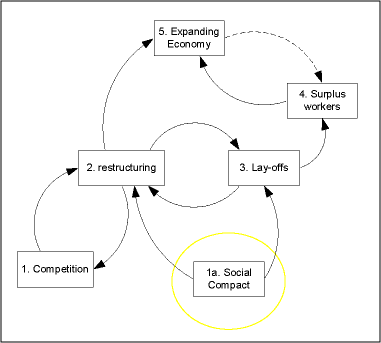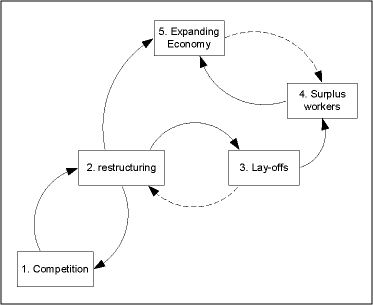
Under normal circumstances the relationship between Box 1 and Box 2 should be a counterbalancing loop rather than a reinforcing one. But if competition is very intense, what results is reinforcing loop. This is the current reality.
Box 2 inevitably leads to laying off workers (Box 3). Also the relationship between Box 2 and Box 3 this should be a counterbalancing loop instead of a reinforcing one. The more workers are laid off, the less willing society is able to tolerate more job cuts. So the arrow from Box 3 to Box 2 should be a dashed arrow. But if a society have forged a very strong social compact (Box 1a), we will see a reinforcing loop instead. And all this is driven by a very powerful Box 1 created by a globalizing environment.
Box 2 is unsustainable unless it yields an expanding economy (Box 5) that is a net creator of jobs, and eventually higher quality jobs. It will soak up the surplus labour (Box 4). If Box 5 accelerates too quickly, then wages will begin to inflate. It is a counterbalancing loop between Box 5 and Box 4.

This NaviMap is similar to the previous case except that Box 1a – the social compact, is absent. In most societies, no matter how intense competition (Box 1) is at pressurizing for restructuring (Box 2), the pace of restructuring is paced by how much that society accepts massive lay offs of workers. The relationship between Box 2 and Box 3 is usually a counterbalancing one. As a result, Box 5 for this scenario is an economy that is expanding more slowly than the previous example. Fewer people are laid off and it is also harder for them to find new jobs compared to the first case. This society will achieve lower economic growth and eventually lower family incomes than the former case.
No comments:
Post a Comment